Related Research Articles
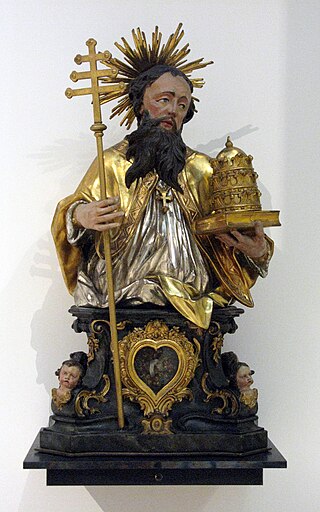
Pope Linus was the bishop of Rome from c. AD 68 to his death. He is generally regarded as the second Bishop of Rome, after St. Peter. As with all the early popes, he was canonized.

Pope Alexander I was the bishop of Rome from about 108/109 to 116/119. Some believe he suffered martyrdom under the Roman emperor Trajan or Hadrian.
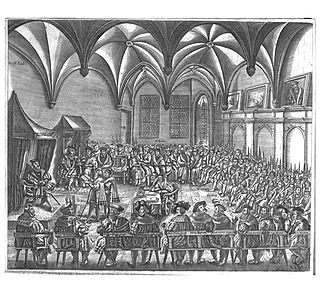
Year 1555 (MDLV) was a common year starting on Tuesday of the Julian calendar.

Mark the Evangelist, also known as John Mark or Saint Mark, is the person who is traditionally ascribed to be the author of the Gospel of Mark. Modern Bible scholars have concluded that the Gospel of Mark was written by an anonymous author rather than an identifiable historical figure. According to Church tradition, Mark founded the episcopal see of Alexandria, which was one of the five most important sees of early Christianity. His feast day is celebrated on April 25, and his symbol is the winged lion.
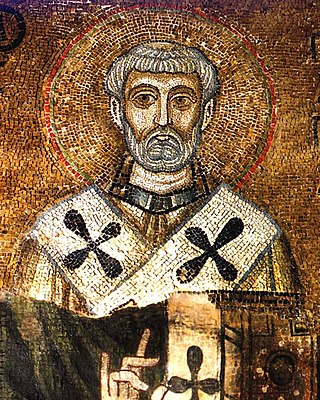
Clement of Rome, also known as Pope Clement I, was a bishop of Rome in the late first century AD. He is considered to be the first of the Apostolic Fathers of the Church, and a leading member of the Church in Rome in the late 1st century.
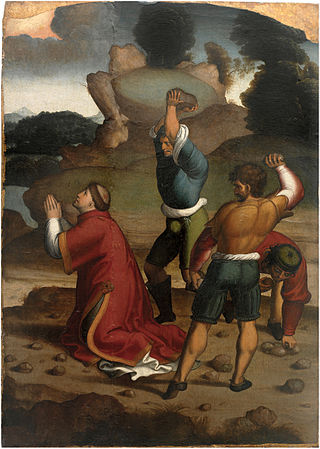
In Christianity, a martyr is a person who was killed for their testimony for Jesus or faith in Jesus. In the years of the early church, stories depict this often occurring through death by sawing, stoning, crucifixion, burning at the stake, or other forms of torture and capital punishment. The word martyr comes from the Koine word μάρτυς, mártys, which means "witness" or "testimony".

The Forty Martyrs of England and Wales or Cuthbert Mayne and Thirty-Nine Companion Martyrs are a group of Catholic, lay and religious, men and women, executed between 1535 and 1679 for treason and related offences under various laws enacted by Parliament during the English Reformation. The individuals listed range from Carthusian monks who in 1535 declined to accept Henry VIII's Act of Supremacy, to seminary priests who were caught up in the alleged Popish Plot against Charles II in 1679. Many were sentenced to death at show trials, or with no trial at all.
A martyrology is a catalogue or list of martyrs and other saints and beati arranged in the calendar order of their anniversaries or feasts. Local martyrologies record exclusively the custom of a particular Church. Local lists were enriched by names borrowed from neighbouring churches. Consolidation occurred, by the combination of several local martyrologies, with or without borrowings from literary sources.
John Lowe (1553–1586) was an English Catholic priest and martyr.

Joseph Marchand was a French missionary in Vietnam and a member of the Paris Foreign Missions Society. He is now a Catholic saint, celebrated on 30 November.
Francis Ingleby was a Roman Catholic martyr executed in York, England during the reign of Elizabeth I.
John Sandys was an English Roman Catholic priest. He is a Catholic martyr, beatified in 1987, and is commemorated on 11 August.

Margaret Clitherow was an English saint and martyr of the Roman Catholic Church, known as "the Pearl of York". She was pressed to death for refusing to enter a plea to the charge of harbouring Catholic priests. She was canonised in 1970 by Pope Paul VI.
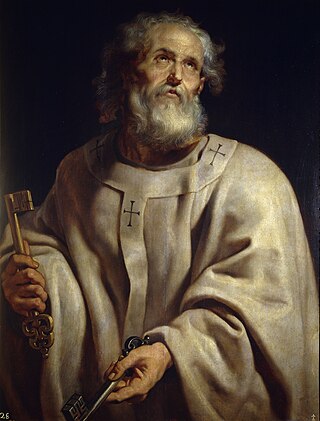
Saint Peter, also known as Peter the Apostle, Simon Peter, Simeon, Simon, or Cephas, was one of the Twelve Apostles of Jesus Christ and one of the first leaders of the early Christian Church. He appears repeatedly and prominently in all four New Testament gospels as well as the Acts of the Apostles. Catholic tradition accredits Peter as the first bishop of Rome—or pope—and also as the first bishop of Antioch.
Nicholas Woodfen born Nicholas Wheeler, also known as Nicholas Devereux, was an English Roman Catholic priest who was hanged, drawn and quartered at Tyburn, London on 21 January 1586. He is considered a Catholic martyr and one of the Eighty-five martyrs of England and Wales who were executed between 1584 and 1679. He was beatified on 22 November 1987 by Pope John Paul II.
Edward Burden (c.1540–1588) was a sixteenth century recusant priest.
George Douglas (c. 1540-1587) was one of the Eighty-five martyrs of England and Wales.
William Lampley was a sixteenth-century English recusant. A glover by trade, he was described as being 'little of education, yet with an almost apostolic zeal in religion.' Apparently betrayed by one whom he had recently aided, he was convicted of assisting priests. He was executed in Gloucester on 1 August 1588.
References
- 1 2 3 4 Matthew Bunson; Margaret Bunson; Pope John Paul II; Stephen Bunson (1999). John Paul II's Book of Saints. Our Sunday Visitor Publishing. pp. 287–. ISBN 978-0-87973-934-8.
- ↑ Ferdinand Holböck (2000). New Saints and Blesseds of the Catholic Church. Ignatius Press. pp. 266–. ISBN 978-0-89870-871-4.
- 1 2 Basil Watkins (19 November 2015). The Book of Saints: A Comprehensive Biographical Dictionary. Bloomsbury Academic. pp. 196–. ISBN 978-0-567-66456-3.
- ↑ Whitfield, Joseph L., "Venerable Alexander Crow", Lives of the English Martyrs, (Edwin Hubert Burton and John Hungerford Pollen,eds.) Longmans, Green and Co., 1914, 323.
 This article incorporates text from this source, which is in the public domain .
This article incorporates text from this source, which is in the public domain . - ↑ Richard Challoner (1836). Modern British Martyrology: Commencing with the Reformation, A.D. 1535, 26th Henry VIII. to A.D. 1684, 24th Charles II. Keating, Brown. pp. 151–.